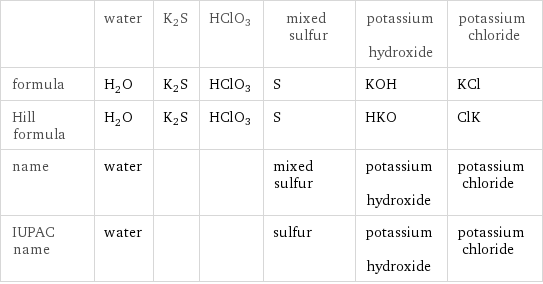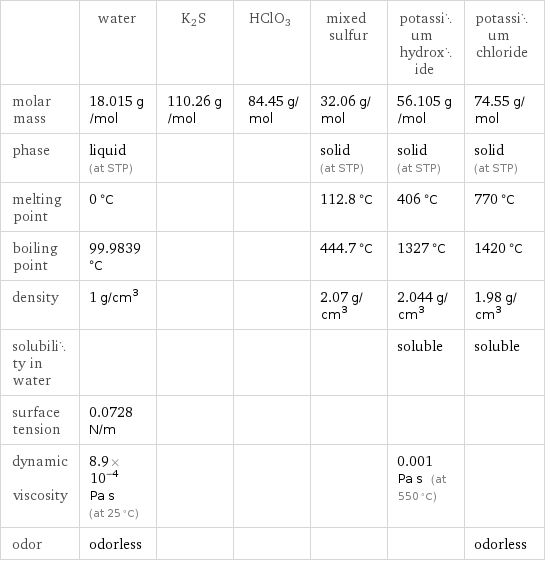Input interpretation

H_2O water + K2S + HClO3 ⟶ S mixed sulfur + KOH potassium hydroxide + KCl potassium chloride
Balanced equation

Balance the chemical equation algebraically: H_2O + K2S + HClO3 ⟶ S + KOH + KCl Add stoichiometric coefficients, c_i, to the reactants and products: c_1 H_2O + c_2 K2S + c_3 HClO3 ⟶ c_4 S + c_5 KOH + c_6 KCl Set the number of atoms in the reactants equal to the number of atoms in the products for H, O, K, S and Cl: H: | 2 c_1 + c_3 = c_5 O: | c_1 + 3 c_3 = c_5 K: | 2 c_2 = c_5 + c_6 S: | c_2 = c_4 Cl: | c_3 = c_6 Since the coefficients are relative quantities and underdetermined, choose a coefficient to set arbitrarily. To keep the coefficients small, the arbitrary value is ordinarily one. For instance, set c_3 = 1 and solve the system of equations for the remaining coefficients: c_1 = 2 c_2 = 3 c_3 = 1 c_4 = 3 c_5 = 5 c_6 = 1 Substitute the coefficients into the chemical reaction to obtain the balanced equation: Answer: | | 2 H_2O + 3 K2S + HClO3 ⟶ 3 S + 5 KOH + KCl
Structures

+ K2S + HClO3 ⟶ + +
Names

water + K2S + HClO3 ⟶ mixed sulfur + potassium hydroxide + potassium chloride
Equilibrium constant
![Construct the equilibrium constant, K, expression for: H_2O + K2S + HClO3 ⟶ S + KOH + KCl Plan: • Balance the chemical equation. • Determine the stoichiometric numbers. • Assemble the activity expression for each chemical species. • Use the activity expressions to build the equilibrium constant expression. Write the balanced chemical equation: 2 H_2O + 3 K2S + HClO3 ⟶ 3 S + 5 KOH + KCl Assign stoichiometric numbers, ν_i, using the stoichiometric coefficients, c_i, from the balanced chemical equation in the following manner: ν_i = -c_i for reactants and ν_i = c_i for products: chemical species | c_i | ν_i H_2O | 2 | -2 K2S | 3 | -3 HClO3 | 1 | -1 S | 3 | 3 KOH | 5 | 5 KCl | 1 | 1 Assemble the activity expressions accounting for the state of matter and ν_i: chemical species | c_i | ν_i | activity expression H_2O | 2 | -2 | ([H2O])^(-2) K2S | 3 | -3 | ([K2S])^(-3) HClO3 | 1 | -1 | ([HClO3])^(-1) S | 3 | 3 | ([S])^3 KOH | 5 | 5 | ([KOH])^5 KCl | 1 | 1 | [KCl] The equilibrium constant symbol in the concentration basis is: K_c Mulitply the activity expressions to arrive at the K_c expression: Answer: | | K_c = ([H2O])^(-2) ([K2S])^(-3) ([HClO3])^(-1) ([S])^3 ([KOH])^5 [KCl] = (([S])^3 ([KOH])^5 [KCl])/(([H2O])^2 ([K2S])^3 [HClO3])](../image_source/d9885b924cf3abbb779ce9891255a4f4.png)
Construct the equilibrium constant, K, expression for: H_2O + K2S + HClO3 ⟶ S + KOH + KCl Plan: • Balance the chemical equation. • Determine the stoichiometric numbers. • Assemble the activity expression for each chemical species. • Use the activity expressions to build the equilibrium constant expression. Write the balanced chemical equation: 2 H_2O + 3 K2S + HClO3 ⟶ 3 S + 5 KOH + KCl Assign stoichiometric numbers, ν_i, using the stoichiometric coefficients, c_i, from the balanced chemical equation in the following manner: ν_i = -c_i for reactants and ν_i = c_i for products: chemical species | c_i | ν_i H_2O | 2 | -2 K2S | 3 | -3 HClO3 | 1 | -1 S | 3 | 3 KOH | 5 | 5 KCl | 1 | 1 Assemble the activity expressions accounting for the state of matter and ν_i: chemical species | c_i | ν_i | activity expression H_2O | 2 | -2 | ([H2O])^(-2) K2S | 3 | -3 | ([K2S])^(-3) HClO3 | 1 | -1 | ([HClO3])^(-1) S | 3 | 3 | ([S])^3 KOH | 5 | 5 | ([KOH])^5 KCl | 1 | 1 | [KCl] The equilibrium constant symbol in the concentration basis is: K_c Mulitply the activity expressions to arrive at the K_c expression: Answer: | | K_c = ([H2O])^(-2) ([K2S])^(-3) ([HClO3])^(-1) ([S])^3 ([KOH])^5 [KCl] = (([S])^3 ([KOH])^5 [KCl])/(([H2O])^2 ([K2S])^3 [HClO3])
Rate of reaction
![Construct the rate of reaction expression for: H_2O + K2S + HClO3 ⟶ S + KOH + KCl Plan: • Balance the chemical equation. • Determine the stoichiometric numbers. • Assemble the rate term for each chemical species. • Write the rate of reaction expression. Write the balanced chemical equation: 2 H_2O + 3 K2S + HClO3 ⟶ 3 S + 5 KOH + KCl Assign stoichiometric numbers, ν_i, using the stoichiometric coefficients, c_i, from the balanced chemical equation in the following manner: ν_i = -c_i for reactants and ν_i = c_i for products: chemical species | c_i | ν_i H_2O | 2 | -2 K2S | 3 | -3 HClO3 | 1 | -1 S | 3 | 3 KOH | 5 | 5 KCl | 1 | 1 The rate term for each chemical species, B_i, is 1/ν_i(Δ[B_i])/(Δt) where [B_i] is the amount concentration and t is time: chemical species | c_i | ν_i | rate term H_2O | 2 | -2 | -1/2 (Δ[H2O])/(Δt) K2S | 3 | -3 | -1/3 (Δ[K2S])/(Δt) HClO3 | 1 | -1 | -(Δ[HClO3])/(Δt) S | 3 | 3 | 1/3 (Δ[S])/(Δt) KOH | 5 | 5 | 1/5 (Δ[KOH])/(Δt) KCl | 1 | 1 | (Δ[KCl])/(Δt) (for infinitesimal rate of change, replace Δ with d) Set the rate terms equal to each other to arrive at the rate expression: Answer: | | rate = -1/2 (Δ[H2O])/(Δt) = -1/3 (Δ[K2S])/(Δt) = -(Δ[HClO3])/(Δt) = 1/3 (Δ[S])/(Δt) = 1/5 (Δ[KOH])/(Δt) = (Δ[KCl])/(Δt) (assuming constant volume and no accumulation of intermediates or side products)](../image_source/92b996a35307333ae6ba212b2cb1718a.png)
Construct the rate of reaction expression for: H_2O + K2S + HClO3 ⟶ S + KOH + KCl Plan: • Balance the chemical equation. • Determine the stoichiometric numbers. • Assemble the rate term for each chemical species. • Write the rate of reaction expression. Write the balanced chemical equation: 2 H_2O + 3 K2S + HClO3 ⟶ 3 S + 5 KOH + KCl Assign stoichiometric numbers, ν_i, using the stoichiometric coefficients, c_i, from the balanced chemical equation in the following manner: ν_i = -c_i for reactants and ν_i = c_i for products: chemical species | c_i | ν_i H_2O | 2 | -2 K2S | 3 | -3 HClO3 | 1 | -1 S | 3 | 3 KOH | 5 | 5 KCl | 1 | 1 The rate term for each chemical species, B_i, is 1/ν_i(Δ[B_i])/(Δt) where [B_i] is the amount concentration and t is time: chemical species | c_i | ν_i | rate term H_2O | 2 | -2 | -1/2 (Δ[H2O])/(Δt) K2S | 3 | -3 | -1/3 (Δ[K2S])/(Δt) HClO3 | 1 | -1 | -(Δ[HClO3])/(Δt) S | 3 | 3 | 1/3 (Δ[S])/(Δt) KOH | 5 | 5 | 1/5 (Δ[KOH])/(Δt) KCl | 1 | 1 | (Δ[KCl])/(Δt) (for infinitesimal rate of change, replace Δ with d) Set the rate terms equal to each other to arrive at the rate expression: Answer: | | rate = -1/2 (Δ[H2O])/(Δt) = -1/3 (Δ[K2S])/(Δt) = -(Δ[HClO3])/(Δt) = 1/3 (Δ[S])/(Δt) = 1/5 (Δ[KOH])/(Δt) = (Δ[KCl])/(Δt) (assuming constant volume and no accumulation of intermediates or side products)
Chemical names and formulas

| water | K2S | HClO3 | mixed sulfur | potassium hydroxide | potassium chloride formula | H_2O | K2S | HClO3 | S | KOH | KCl Hill formula | H_2O | K2S | HClO3 | S | HKO | ClK name | water | | | mixed sulfur | potassium hydroxide | potassium chloride IUPAC name | water | | | sulfur | potassium hydroxide | potassium chloride
Substance properties

| water | K2S | HClO3 | mixed sulfur | potassium hydroxide | potassium chloride molar mass | 18.015 g/mol | 110.26 g/mol | 84.45 g/mol | 32.06 g/mol | 56.105 g/mol | 74.55 g/mol phase | liquid (at STP) | | | solid (at STP) | solid (at STP) | solid (at STP) melting point | 0 °C | | | 112.8 °C | 406 °C | 770 °C boiling point | 99.9839 °C | | | 444.7 °C | 1327 °C | 1420 °C density | 1 g/cm^3 | | | 2.07 g/cm^3 | 2.044 g/cm^3 | 1.98 g/cm^3 solubility in water | | | | | soluble | soluble surface tension | 0.0728 N/m | | | | | dynamic viscosity | 8.9×10^-4 Pa s (at 25 °C) | | | | 0.001 Pa s (at 550 °C) | odor | odorless | | | | | odorless
Units
